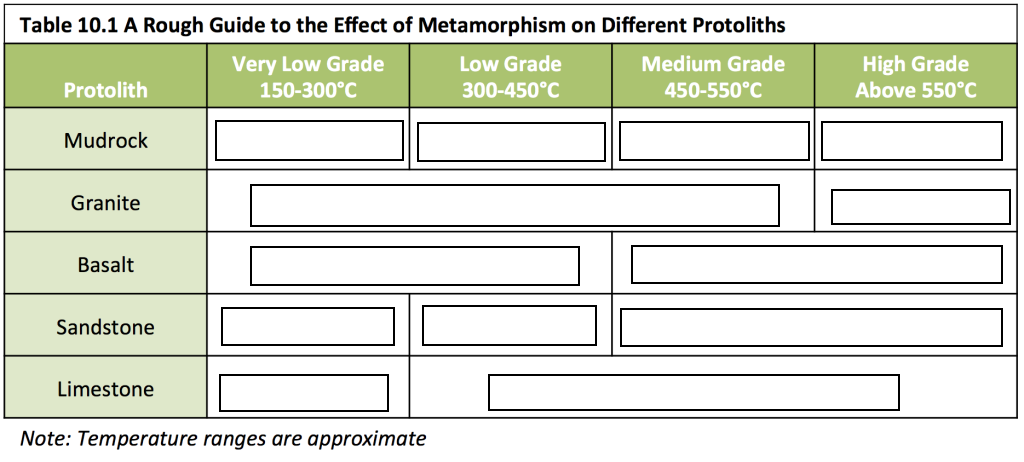10.3. Metamorphism and Metamorphic Rocks – Review Questions
- What are the principle agents of metamorphism in rocks?
- Marble is a metamorphic rock that forms when limestone is metamorphosed. What do marble and limestone have in common? What is different? Go through the other metamorphic rocks described in the lectures and textbook and describe the similarities and differences these rocks have from their protoliths. Note: some metamorphic rocks have more than one possible protolith.
- How does the depth of the 300°C isotherm in the crust vary across the various kinds of tectonic margins?
- Describe how fluids are involved in metamorphism. What are the two fluids that are most important in metamorphism?
- What is the temperature range over which metamorphism normally occurs? Why doesn’t metamorphism generally occur at even higher temperatures?
- Describe how heat and pressure are important in metamorphism.
- What changes can occur in minerals due to metamorphism?
- What are the possible sources of fluids in metamorphic rocks?
- What common minerals found in metamorphic rocks are not useful as index minerals? Why not?
- List examples of minerals only formed by metamorphic processes, and describe each mineral.
- As metamorphic grade increases, what do we generally observe in terms of the degree of foliation in rocks? Why?
- How are foliated rocks classified? Give examples of foliated rocks, describe what minerals they contain, and draw their textures.
- What is the difference between foliation and cleavage?
- Would you expect to find foliated and/or non-foliated metamorphic rocks in each type of metamorphic environment listed in this chapter?
- How can we use the metamorphic facies of a metamorphic rock to understand the pressure and temperature history of the rock?
- What facies would you expect to see in:
- contact metamorphosed rocks?
- a volcanic arc?
- mountains generated by a continent-continent plate boundary?
-
Draw and describe confining (lithostatic) pressure, directed pressure, and differential stress. What metamorphic textures are associated with each?
- Draw and label the following metamorphic environments. Describe features associated with metamorphism in each environment. How will the amount and type of metamorphism vary as you move across each environment?
- contact metamorphism
- high-pressure metamorphism
- seafloor hydrothermal metamorphism
- burial metamorphism
-
Draw and label a diagram illustrating regional metamorphism. Describe features associated with metamorphism in this environment. How will the amount and type of metamorphism vary as you move across the environment?
-
Draw and label features of the following metamorphic rock textures. Under what conditions do you expect each to form? What metamorphic environments? List a specific location in the world where you would you expect to find each type of metamorphic rock.
- banded gneiss
- schistose
- slaty rock cleavage
- Fill in the metamorphic rocks corresponding to each protolith in the following table.

Extra review questions that may be covered in lecture (depending on your professor) that are not completely covered in the the textbook readings:
- What four factors drive metamorphism? How do these factors differ across an area affected by regional metamorphism (e.g., a continent-continent plate boundary)
- List and describe examples of index minerals for low, medium, and high grade metamorphism.
- What are the defining features of metamorphic textures? Describe the three general classes of metamorphic textures, draw them, and give examples of each.
-
Draw and label the following textures for practice. What environments do each texture form in? Would you expect to find each texture in an igneous rock or a metamorphic rock?
- aphanitic
- phaneritic
- porphyritic
- porphyroblastic
- granoblastic




